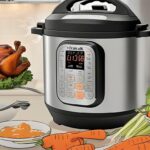Welcome, dear reader! If you’re looking for a flavorful and tender way to prepare deer backstrap, look no further. In this section, I will share with you the art of skillet cooking deer backstrap. Whether you’re a seasoned cook or a beginner in the kitchen, this guide will provide you with step-by-step instructions to achieve mouthwatering results. Let’s get started!
Key Takeaways:
- Cooking deer backstrap in a skillet is a delicious and easy way to prepare this wild game meat.
- Skillet cooking techniques such as proper seasoning and searing are essential for achieving tender and flavorful results.
- By following this guide, you can confidently prepare an easy and mouthwatering recipe using deer backstrap.
Skillet Cooking Techniques for Deer Backstrap
If you want to master the art of cooking deer backstrap in a skillet, it’s important to understand some essential cooking techniques. Whether you’re a beginner or a seasoned cook, these tips and tricks will help you achieve tender, juicy results every time.
1. Properly Season the Meat
Before cooking the deer backstrap, it’s important to season it properly. I recommend using a simple, yet flavorful blend of salt, black pepper, and garlic powder. This will enhance the natural flavors of the meat without overpowering it.
2. Sear the Meat
One of the most important skillet cooking techniques for deer backstrap is to sear the meat. This involves cooking the meat over high heat for a short period of time to achieve a crispy, caramelized exterior. To do this, heat a small amount of oil in a skillet until it’s hot, but not smoking. Then, add the seasoned deer backstrap to the skillet and cook for 2-3 minutes per side until it’s browned.
3. Control the Heat
Controlling the heat is key when cooking deer backstrap in a skillet. You want to maintain a consistent temperature to ensure even cooking and prevent the meat from overcooking. To do this, start by searing the deer backstrap over high heat, then reduce the heat to medium and continue cooking until it reaches your desired level of doneness.
4. Let it Rest
After cooking the deer backstrap, it’s important to let it rest for a few minutes before slicing and serving. This allows the juices to redistribute throughout the meat, resulting in a tender, juicy texture. I recommend letting the deer backstrap rest for at least 5 minutes before slicing and serving.
By following these skillet cooking techniques, you’ll be able to prepare a delicious and memorable deer backstrap dish. Whether you’re a beginner or an experienced cook, these tips and tricks will help you achieve tender, juicy results every time you cook deer backstrap in a skillet.
Easy Skillet Recipe for Deer Backstrap
Are you looking for a hassle-free way to cook deer backstrap in a skillet? Look no further than this delicious and easy recipe that will impress even the pickiest eaters. With just a few simple ingredients and minimal prep time, you’ll have a mouth-watering dinner ready in no time.
Ingredients:
- 1 pound of deer backstrap
- 2 tablespoons of butter
- 1 tablespoon of olive oil
- 2 cloves of garlic, finely chopped
- 1 tablespoon of fresh rosemary, finely chopped
- Salt and pepper, to taste
Instructions:
- Remove the backstrap from the fridge and let it sit at room temperature for 30 minutes.
- Season the backstrap generously with salt and pepper on both sides.
- Heat a skillet over high heat, add the butter and olive oil, and let it melt.
- Add the backstrap to the skillet and cook for 2-3 minutes on each side, until browned.
- Reduce the heat to medium, add the garlic and rosemary, and cook for an additional 1-2 minutes.
- Once the backstrap reaches an internal temperature of 130°F (medium-rare), remove it from the skillet and let it rest for 5 minutes.
- Slice the backstrap against the grain and serve hot.
That’s it! This easy skillet recipe for deer backstrap is perfect for a quick weeknight dinner or a special occasion. The rosemary and garlic add a delicious and aromatic flavor to the dish, while the butter and oil ensure a tender and juicy result. You can also experiment with different herbs and spices to create your own unique twist on this classic dish.
Now that you have the best skillet recipe for deer backstrap, it’s time to gather your ingredients and start cooking!
Skillet Cooking Techniques for Deer Backstrap
If you want to take your deer backstrap dish to the next level, mastering essential skillet cooking techniques is crucial. Here are my tips and tricks for achieving a juicy and flavorful result:
- Preparation: Before cooking the backstrap, let it sit at room temperature for 30 minutes to an hour. This will help it cook evenly.
- Seasoning: Generously season the meat with salt and pepper on both sides. You can also add your favorite herbs or spices to enhance the flavors.
- Searing: Heat the skillet over high heat and add a tablespoon of oil. When the oil is hot, place the backstrap in the skillet and sear for 2-3 minutes per side until browned.
- Cooking: Lower the heat to medium and continue cooking the backstrap for another 6-10 minutes, depending on your desired level of doneness. Use a meat thermometer to ensure the internal temperature reaches 135°F for medium-rare, 145°F for medium, and 160°F for well-done.
- Resting: Once cooked, remove the backstrap from the skillet and let it rest for 5-10 minutes. This allows the juices to redistribute and keep the meat tender and juicy.
By following these simple skillet cooking techniques, you’ll be able to impress your guests with a perfectly cooked deer backstrap every time. Keep practicing and experimenting, and soon you’ll master the art of skillet cooking!
Skillet Cooking Ideas for Deer Backstrap
Now that you have the basics of skillet cooking down, it’s time to get creative with your deer backstrap. Here are some ideas to inspire you:
- Classic seasoning: Keep it simple with salt, pepper, and olive oil. This lets the natural flavor of the meat shine through.
- Southwest spice: Rub the backstrap with a blend of cumin, chili powder, and paprika for a smoky, slightly spicy flavor.
- Asian fusion: Marinate the backstrap in soy sauce, ginger, and garlic for a teriyaki-style dish that pairs well with rice and veggies.
- Fruit glaze: Brush the backstrap with a mixture of honey and orange juice for a sweet and tangy twist.
- Bacon-wrapped: Wrap the backstrap in bacon before searing it for added flavor and moisture.
Remember to experiment with different herbs, spices, and marinades to discover your own perfect skillet-cooked deer backstrap. Don’t be afraid to get creative and add your personal touch to create an even more extraordinary culinary experience.
Conclusion
Congratulations! You’ve learned how to cook deer backstrap in a skillet with confidence. By following the techniques, recipe, and ideas shared in this guide, you’re now equipped to create a delicious and memorable dish using this wild game meat. Don’t be afraid to add your personal touch, spice things up, and experiment with different flavors to make your skillet-cooked deer backstrap even more extraordinary.
Remember, cooking is an art, and practice makes perfect. The more you experiment, the better you’ll become. Keep your skillet hot and your seasonings bold, and you’re sure to impress your family and friends with your culinary skills.
Thank you for joining me in this adventure of skillet cooking deer backstrap. I hope you’ve enjoyed it as much as I have. Happy cooking!
FAQ
Q: How long should I cook deer backstrap in a skillet?
A: The cooking time for deer backstrap in a skillet will depend on how you like your meat cooked. As a general guideline, you can cook it for about 3-4 minutes per side for a medium-rare result. Adjust the time accordingly if you prefer a different level of doneness.
Q: Can you cook deer backstrap in a non-stick skillet?
A: Yes, you can definitely cook deer backstrap in a non-stick skillet. Just make sure to preheat the skillet properly and use a small amount of cooking oil or butter to prevent sticking.
Q: Should I marinate the deer backstrap before cooking?
A: Marinating the deer backstrap can add extra flavor and tenderness to the meat. You can marinate it for a few hours or overnight in your preferred marinade before cooking. However, it’s not necessary if you prefer the natural flavor of the meat.
Q: What is the ideal internal temperature for cooked deer backstrap?
A: The ideal internal temperature for cooked deer backstrap is 125-130°F (52-54°C) for medium-rare. Use a meat thermometer to ensure that the meat reaches the desired temperature, and let it rest for a few minutes before slicing.
Q: Can I use frozen deer backstrap for skillet cooking?
A: It’s recommended to thaw the deer backstrap before skillet cooking to ensure even cooking and better flavor. Thaw the meat in the refrigerator overnight or use the defrost function on your microwave if you’re short on time.
- What is a Stock Pot Used for in Cooking? - September 5, 2023
- How to Make Turkey Stock in Instant Pot - September 5, 2023
- How to Make Gravy from Pot Roast Stock - September 5, 2023






